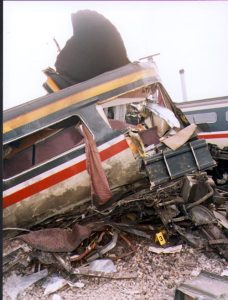Introduction:
On the fateful day of September 19, 1997, the quiet suburb of Southall in West London became the epicenter of a catastrophic event that shook the foundations of railway safety. The Southall rail crash, as it came to be known, left an indelible mark on the history of train transportation in the United Kingdom, raising critical questions about infrastructure, communication, and passenger safety.
Background:
The Southall derailment occurred at a time when the British rail network was undergoing significant changes. The privatization of British Rail had introduced new challenges, and the focus on efficiency and cost-cutting measures sometimes overshadowed safety concerns. The ill-fated day would expose the vulnerabilities in the system, leading to a renewed emphasis on ensuring the safety of both passengers and railway personnel.
The Incident:

The morning of September 19 started like any other, with the 6:30 AM Great Western Trains service departing from Swansea to London Paddington. However, tragedy struck as the train approached Southall station. The high-speed intercity train collided with a freight train that had been given a clear signal to enter the same track. The impact was devastating, resulting in the derailment of several carriages.
Causes:
The subsequent investigation pointed to a failure in communication and signaling as the primary causes of the Southall derailment. The crew of the freight train misinterpreted signals, leading to a catastrophic misunderstanding of the track occupancy. The Railtrack, responsible for the management of tracks and signals, came under scrutiny for lapses in the signaling system. Additionally, questions were raised about the training and readiness of the crew members on both trains.
Casualties and Injuries:
The consequences of the Southall rail crash were severe. Seven passengers lost their lives, and over 150 others suffered injuries, some of them life-changing. The incident underscored the importance of stringent safety measures and comprehensive training for railway personnel to prevent such tragic events.
Impact on Railway Safety:
In the aftermath of the Southall derailment, the UK railway industry underwent a paradigm shift in its approach to safety. The Health and Safety Executive (HSE) conducted a thorough investigation and made several recommendations to enhance safety measures across the railway network. The incident prompted a reevaluation of communication protocols, signaling systems, and crew training to prevent similar accidents in the future.
Reforms and Improvements:
The Southall rail crash acted as a catalyst for significant reforms in the railway sector. The Railways Act 1999 introduced a new framework for the industry, with a focus on safety, efficiency, and accountability. The creation of the Rail Safety and Standards Board (RSSB) aimed to consolidate efforts in improving safety standards and implementing best practices.
Lessons Learned:
The Southall derailment served as a grim reminder of the delicate balance between efficiency and safety in railway operations. Lessons learned from the tragedy emphasized the need for continuous improvement, technological advancements, and a culture of safety that prioritizes the well-being of passengers and crew members.
Conclusion:
The Southall rail crash remains etched in the annals of railway history as a poignant reminder of the devastating consequences that can result from lapses in communication and safety protocols. The lessons learned from this tragic event have played a crucial role in shaping the safety landscape of the UK railway industry, emphasizing the importance of vigilance, accountability, and a commitment to continuous improvement. As the industry continues to evolve, the memory of the Southall derailment serves as a solemn call to ensure that the safety of passengers and personnel remains paramount in the ever-changing landscape of railway transportation.



